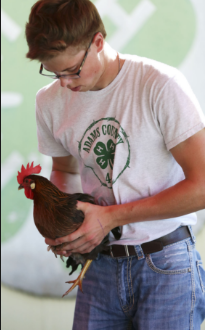*This story was featured in the Hastings Tribune on July 23, 2016.
On a warm Friday morning, 4-H’ers gathered beneath a tent at the Adams County Fairgrounds to showcase their most prized poultry.
The show, which didn’t allow for the entering of live birds last year because of the threat of avian flu, was back to normal this time around.
This year’s broilers class — one of four different classes of competition — featured kids of all ages showing off the birds they’ve worked with for six straight weeks.
“Everyone gets chicks from the same production facility on the same day, so they start out of the gate running at the same place,” said Lynn Devries, extension educator for Adams County. “The broilers is a six-week project from the start of day one baby chicks until today, where they’re market ready.”
The morning kicked off with the broiler’s competition, followed by the showmanship, bantam class and clover kids competitions.
Every 4-H’er receives a ribbon for their submissions, which can act as an incentive for the extensive preparation needed to enter these birds into the show.
“A lot of preparation is needed for any show,” said 16-year old Dariana Burr of Juniata. “We have to get the cages ready, bathe the birds, polish their beaks, trim their nails, clean their legs. Birds are so dirty, so that takes a lot of time.”
After getting the birds ready for competition, 4-H’ers bring their birds to the fairgrounds and anxiously wait to hear from the judges.
Birds are judged according to the American Standard of Perfection standards, and depending on the class, can be judged on any number of things including meat capacity, plumage, comb quality and health of the bird’s feet.
One aspect of competition in particular requires a special amount of courage, knowledge of the bird and speaking skill. The showmanship portion involves a participant explaining the anatomy of the bird, identifying the types of feathers and posing the bird in front of a judge, along with the crowd, which can be quite the daunting task.
But for Burr, she tends to think of the opportunity as a chance to perfect some real life skills.
“The speaking experience, getting out in front of people, it’s really hard, but it helps you later on with college, high school and job interviews,” she said. “It’s just a great way to learn.”
While the 4-H’ers are often eager to receive recognition for their work in the form of purple, blue or red ribbons, to some, the competition can also be used to teach a lesson or two.
“I think it (the competition) just gives them a lot of confidence and some independent skills, as well. Many of our 4-H’ers are building responsibility and showing they can grow and take care of an animal,” Devries said. “It’s a project with a little guidance from their family. It’s something they can do on their own.”
In Burr’s case, being a part of a family full of 4-H’ers has not only kept her involved with 4-H, but has even prompted her to ponder a career working with animals.
“My mom was a veterinarian, so it makes you really get familiar with it,” she said. “I think I could see myself being a vet in the future.”

